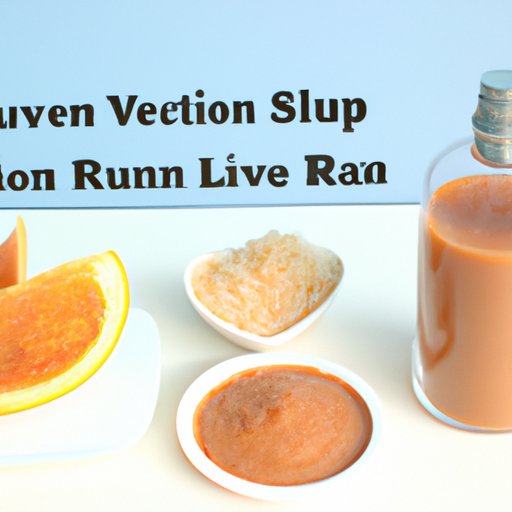Introduction
One of the most common side effects of sun exposure is sunburn. Most people have experienced sunburn at some point in their lives, and those who spend a lot of time outdoors are even more vulnerable to its effects. While the main symptom of sunburn is usually redness and pain, another common side effect is skin peeling. This article will explore why skin peels after a sunburn, as well as the causes, effects, and treatment options.

Exploring the Science Behind Sunburn Peeling
When exposed to ultraviolet (UV) rays from the sun, the skin produces melanin, which is a pigment that helps protect the skin from sun damage. If the skin is exposed to too much UV radiation, the body can’t produce enough melanin to protect the skin, resulting in sunburn. The sunburned skin can become swollen, red, and painful, and in some cases, it can also lead to skin peeling.
The role of melanin in preventing sunburn damage is twofold. First, it helps to absorb the UV radiation before it can cause any harm to the skin cells. Second, it helps to repair any damage that has already been done by the UV radiation. When the skin is not able to produce enough melanin, it can be more easily damaged by the UV radiation and lead to sunburn.
Understanding the Causes and Effects of Skin Peeling After a Sunburn
Skin peeling after a sunburn occurs when the outer layers of the skin are damaged by the UV radiation. As the skin heals, these outer layers die off and are replaced with new skin cells. This process takes several days and can cause the skin to become dry, flaky, and itchy. In severe cases, large patches of skin may peel off, leaving behind tender, raw skin.
In addition to the discomfort caused by skin peeling, there are also long-term effects. Prolonged sun exposure can increase the risk of developing skin cancer, and skin peeling can make it more difficult for the skin to heal properly and protect itself from future damage.
The Benefits of Letting Your Skin Heal Naturally After Sunburn
The natural healing process can help to speed up the recovery process and reduce the risk of further damage. To promote natural healing after sunburn peeling, it is important to keep the skin hydrated and avoid any activities that may irritate the skin. Applying moisturizers and avoiding direct sunlight can help to soothe the skin and promote healing.
In addition, it is important to be gentle with the skin while it is healing. Avoid scrubbing or picking at the skin, as this can cause further irritation and delay the healing process. It is also important to wear loose-fitting clothing that won’t rub against the skin.
How to Treat Sunburn Peeling Safely
Over-the-counter treatments such as aloe vera gel and hydrocortisone cream can help to soothe the skin and reduce inflammation. These treatments can be applied directly to the affected area to provide relief from discomfort and itching. However, it is important to follow the instructions on the packaging carefully, as these treatments can cause irritation if used incorrectly.
In some cases, medical treatments may be necessary to help treat sunburn peeling. For example, antibiotics may be prescribed to treat any infections that have developed due to the sunburn. Additionally, a doctor may recommend a steroid cream to help reduce inflammation and improve the healing process.

Tips for Preventing Sunburn Peeling
The best way to prevent sunburn peeling is to avoid excessive sun exposure. This can be accomplished by wearing protective clothing, such as long-sleeved shirts, wide-brimmed hats, and sunglasses, when spending time outdoors. Additionally, it is important to apply sunscreen with an SPF of 30 or higher every two hours when spending time in the sun.
It is also important to practice sun safety measures. This includes limiting your time in the sun during peak hours (between 10am and 4pm), seeking shade whenever possible, and taking frequent breaks from the sun. Additionally, it is important to drink plenty of water to stay hydrated and avoid becoming overheated.

Home Remedies to Help Speed Up Skin Peeling After a Sunburn
In addition to over-the-counter treatments, there are also several home remedies that can help to speed up the skin peeling process after a sunburn. Applying cool compresses to the affected area can help to reduce swelling and relieve discomfort. Additionally, applying aloe vera gel to the skin can help to soothe irritation and promote healing.
Taking pain relievers such as ibuprofen or acetaminophen can also help to reduce discomfort. It is important to follow the dosage instructions on the package carefully, as taking too much can cause serious side effects. Additionally, it is important to avoid using products that contain alcohol, as this can further irritate the skin.
Conclusion
In conclusion, skin peeling after a sunburn is a common side effect of sun exposure. The skin peels as the outer layers are damaged by UV radiation and the body is unable to produce enough melanin to protect itself. The effects of sunburn peeling can be uncomfortable and can increase the risk of long-term damage. To minimize the risk, it is important to practice sun safety measures and use over-the-counter treatments and home remedies to help speed up the healing process.


